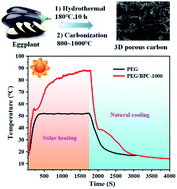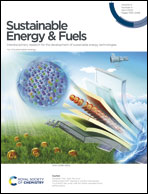Shape-stabilized phase-change materials supported by eggplant-derived porous carbon for efficient solar-to-thermal energy conversion and storage†
Abstract
In order to effectively solve the leakage problem and insufferably low thermal conductivity of organic phase-change materials (PCMs), three-dimensional (3D) spongy-like biological porous carbon (BPC) materials derived from eggplants were used as scaffolds for encapsulating polyethylene glycol (PEG) to fabricate shape-stabilized composite phase-change materials (ss-CPCMs). The relationship between the micro-morphology of the BPC and the heat-storage performance was assessed by controlling the post-pyrolysis temperature to regulate the micro-morphology of the carriers. It was found that the BPC consisting of nanopores and macropores with an average diameter of about 44.758 μm extended a high PEG loading (up to 90.1 wt%), while the hierarchical pores could prevent liquid leakage, enabling a melting enthalpy up to 149 J g−1. The ss-CPCMs also demonstrated excellent thermal cycling properties with a 96.3% retention after 50 cycles. In addition, the hierarchically porous structure of the BPC provides a good network channel for the thermal motion of phonons, which significantly improved the thermal conductivity. Moreover, as an effective photon captor and molecular heater, it could meaningfully improve the solar-to-thermal conversion efficiency of PCM composites. Therefore, the BPC with hierarchical scaffolds and excellent thermal conductivity derived from biomass provides promising applications in PCMs via a low-cost and easy preparation process.



 Please wait while we load your content...
Please wait while we load your content...